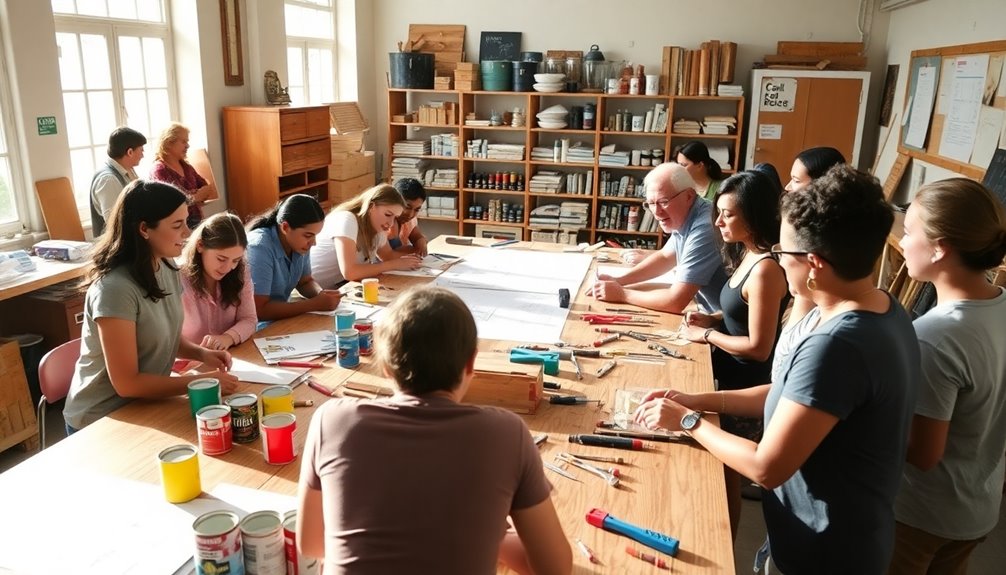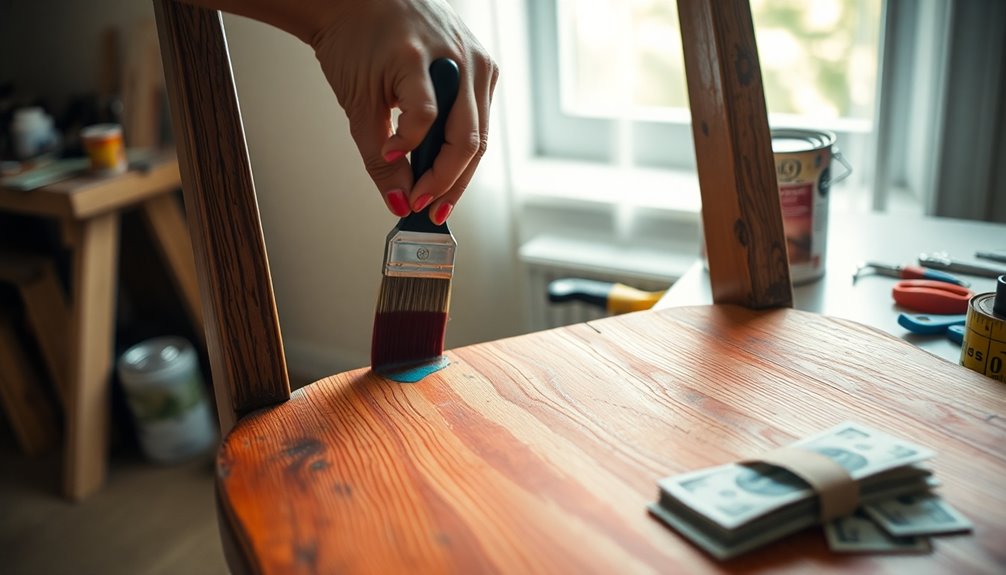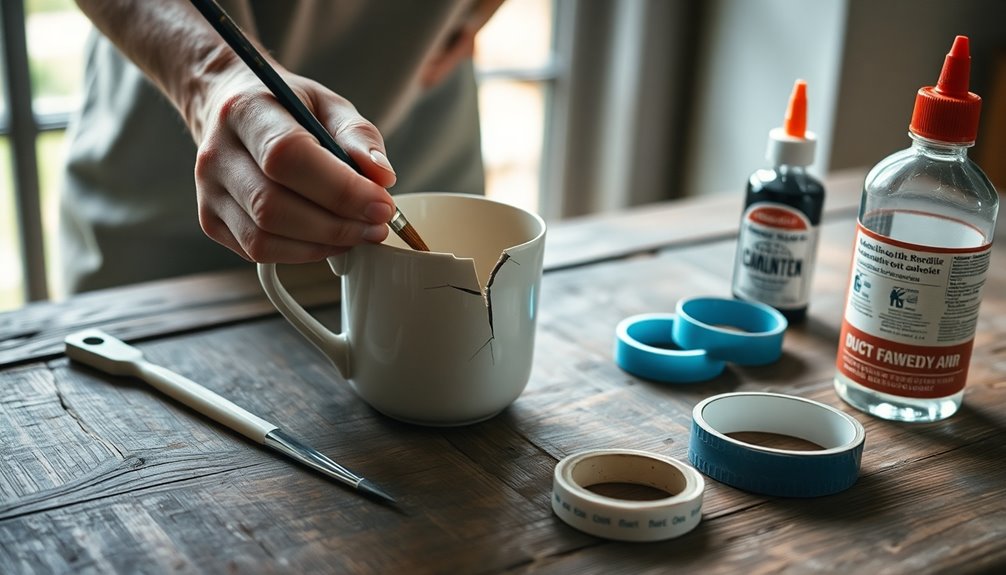Some repairs are better as DIY projects for your budget because you can save a significant amount of money, often between 20-50%, compared to professional services. By handling repairs yourself, you avoid labor fees, which can run $30 to $125 per hour. Plus, you gain valuable skills and build confidence while nurturing a personal connection with your home. Not only can DIY repairs help reduce waste and promote sustainability, but they also offer long-term financial benefits. If you're curious about which repairs are ideal for you to tackle, there's plenty more to explore on this topic.
Benefits of DIY Repairs
When you tackle DIY repairs, you not only save money but also gain valuable skills that can benefit you in the long run.
By engaging in DIY repair projects, you can greatly cut costs, avoiding labor fees that professionals often charge. You might save an impressive 20-50% on common home maintenance tasks like painting or minor plumbing fixes. Additionally, utilizing budget management tools can help you allocate funds effectively for materials and supplies. Furthermore, using AI-driven tools can optimize your product discovery for the supplies you need.
Plus, learning these skills helps prevent future repair issues, potentially saving you thousands over time. Utilizing community resources like Makerspaces gives you access to essential tools and workshops, making your DIY repair journey even more cost-effective. Additionally, managing your expenses effectively through tools like expense management apps can enhance your budgeting capabilities.
Ultimately, the sense of accomplishment you feel boosts your self-esteem and encourages a proactive approach to home maintenance, leading to further savings down the road.
Cost Comparison: Repair vs. Replacement
When considering whether to repair or replace an item, it's essential to weigh the costs carefully.
You might find that simple repairs can save you substantial money, with options often costing a fraction of new purchases. Utilizing tools like budgeting apps can also help you monitor your overall spending and make informed decisions about repairs versus replacements.
Let's explore the financial benefits of repairs and compare some real-life examples to help you make the best choice. Additionally, utilizing expense tracking tools can help you manage the costs associated with repairs effectively.
Repair Savings Overview
While many homeowners might instinctively reach for a new item when something breaks, opting for repairs can lead to substantial savings.
For instance, fixing a coffee maker might only cost you around $20, while replacing it could set you back between $50 and $150. This repair savings overview shows that tackling minor repairs yourself can save you up to 75% on small appliances, especially when the repair is under $100.
A basic sewing kit can mend clothing for under $10, in stark contrast to buying new garments that often exceed $30.
Even fixing a leaky faucet can cost just a few dollars in parts, making DIY repairs a smart way to save money and keep your budget intact.
Long-Term Financial Benefits
Opting to repair rather than replace your appliances can lead to significant long-term financial benefits.
For example, fixing a coffee maker might cost you just $20 in parts, while a new one can run between $50 and $150. Similarly, repairing larger appliances usually costs between $100 and $300—much less than their replacement, which can exceed $1,000.
By choosing repairs, you could save up to 60% on total ownership costs over time. A study showed that repairing household items could save consumers an average of £1.5 billion annually.
Plus, by investing in DIY repair skills, you could see an impressive return on investment of up to 400%. These cost savings can really add up, making repairs a smart financial choice.
Example Cost Comparisons
Repairing your appliances can save you a significant amount of money compared to replacing them. For instance, fixing a coffee maker costs around $30 to $50, while a new one can set you back $100 to $200.
Similarly, washing machine repairs average between $150 and $300, compared to a replacement cost of $600 to $1,200.
Smartphone screen repairs typically run about $100, whereas a new phone might exceed $700.
Reupholstering a chair costs around $200, while a similar quality chair can cost over $500.
Additionally, regular vehicle maintenance can save you roughly $500 annually compared to replacement costs.
Clearly, these examples highlight the significant cost savings that come with choosing repairs over replacements.
Environmental Advantages of Repairing

When you choose to repair instead of replace, you directly contribute to waste reduction and keep tons of materials out of landfills. Each fix helps conserve resources and lowers your carbon footprint, making a positive impact on the environment. By embracing a circular economy, you not only extend the life of your items but also reduce the demand for new products and their associated manufacturing costs. Additionally, opting for sustainable practices during repairs can further enhance your environmental contributions. Supporting ethical brands that prioritize repairable designs can also promote sustainability in the fashion industry.
Waste Reduction Benefits
While many people may not realize it, choosing to repair items instead of tossing them out can have a significant impact on waste reduction. By engaging in DIY projects, you help decrease the staggering 292.4 million tons of trash generated in the U.S. each year.
Every item you repair conserves valuable resources; for instance, recycling an aluminum can uses 95% less energy than producing a new one. Additionally, manufacturing new goods contributes heavily to carbon emissions, with one smartphone alone emitting up to 95 kg of CO2.
When you repair instead of replacing, you preserve materials like metals and plastics, reducing the need for environmentally damaging mining and extraction. Your DIY efforts promote sustainability and encourage others to adopt eco-friendly behaviors.
Resource Conservation Impact
Choosing to repair rather than replace not only saves you money but also plays an essential role in conserving our planet's resources. When you engage in DIY repairs, you're preventing valuable materials from being wasted. Each item you fix reduces the need for new raw materials like metals and plastics, which helps combat resource depletion.
For instance, repairing a single appliance can save about 100 pounds of waste from ending up in a landfill. Plus, the repair process emits considerably fewer carbon emissions compared to manufacturing new products.
Lower Carbon Footprint
Repairing items not only conserves resources but also greatly lowers your carbon footprint. By choosing to repair instead of replace, you actively participate in reducing waste and greenhouse gas emissions.
Consider these benefits:
- Save approximately 1,000 pounds of carbon dioxide for each repaired item.
- Reduce the 292.4 million tons of trash generated in the U.S. annually.
- Diminish the demand for new materials through electronics repairs.
- Prevent nearly 39,000 metric tons of CO2 emissions by recycling one million laptops.
- Lower environmental degradation from raw material extraction.
Each repair you make is a step toward sustainability, showing that small actions can lead to significant environmental change.
Common Items for DIY Repair
DIY repairs can breathe new life into common household items, saving you time and money. Some of the most common items for DIY repair include electronics like toasters and coffee makers, where simple fixes can save you from costly replacements. Additionally, utilizing expense tracking apps can help you monitor the costs associated with these repairs and ensure your budget remains on track. Moreover, using budgeting apps can help you identify your spending patterns, making it easier to prioritize repairs.
Furniture repairs, such as fixing wobbly chairs or refinishing surfaces, can also be done at a fraction of the cost. Clothing repairs, including mending tears and reattaching buttons, require just basic sewing skills. Moreover, understanding your expenses through expense categorization can further help you allocate funds for necessary repairs. Embrace these common repair opportunities to keep your budget intact!
Utilizing Community Resources

While tackling repairs on your own can be rewarding, utilizing community resources can elevate your DIY experience even further.
Local Makerspaces, repair events, and online groups offer incredible support and savings. Here's how you can benefit:
- Access tools and equipment without the high costs of buying them.
- Join free or low-cost classes to learn essential repair skills, which can help you develop customer retention strategies through consistent practice. Additionally, participating in these classes can foster a sense of enhancing customer loyalty among peers.
- Participate in community repair events for hands-on assistance.
- Connect with local DIY groups for shared tips and tools.
- Experience a sense of belonging and encouragement from fellow repair enthusiasts.
- By collaborating with fellow DIYers, you can also discover cashback programs that can enhance your savings on tools and materials.
Skills Gained Through DIY Projects
When you tackle DIY projects, you gain practical experience that sharpens your problem-solving skills and boosts your confidence.
Each task you complete not only enhances your abilities but also makes you more self-reliant in handling home repairs.
As you tackle various challenges, you'll notice how much more capable and empowered you feel in your living space. Additionally, engaging in these projects can also help you develop disciplined savings habits that contribute to your long-term financial goals.
Practical Experience Acquired
Engaging in hands-on projects not only transforms your living space but also equips you with valuable skills that extend far beyond simple repairs.
With each DIY endeavor, you gain practical experience that empowers you to tackle various tasks confidently.
You'll find yourself mastering:
- The proper use of essential tools
- Techniques for patching walls and fixing leaks
- Strategies for effective project planning
- Skills to troubleshoot and solve unexpected issues
- The ability to learn from mistakes and improve
As you take on these challenges, you'll cultivate a sense of accomplishment, realizing you can complete tasks that once felt intimidating.
This newfound confidence encourages you to explore even more complex projects, enhancing your practical experience and overall skills in home maintenance.
Problem-Solving Skills Developed
Tackling DIY projects sharpens your problem-solving skills, as you learn to assess issues and devise practical solutions on your own. Each time you face a repair, you'll identify necessary tools and adapt to unexpected challenges, which enhances your adaptability.
With every project, you build resilience, understanding that mistakes are part of the learning curve and that perseverance is vital. You also develop resourcefulness, discovering how to source materials creatively and utilize tools for multiple purposes.
This hands-on experience not only hones your problem-solving skills but also prepares you for increasingly complex tasks. As you gain confidence in your abilities, you'll feel empowered to tackle any DIY challenge that comes your way, enhancing your overall skill set.
Confidence Boosting Opportunities
As you immerse yourself in DIY projects, you'll discover a wealth of skills that not only enhance your practical abilities but also greatly boost your confidence. Each repair reinforces your self-reliance, motivating you to tackle more challenging tasks.
You'll find yourself:
- Mastering woodworking techniques
- Managing plumbing challenges with ease
- Understanding basic electrical work
- Developing creative problem-solving skills
- Experiencing the satisfaction of a job well done
These confidence-boosting opportunities transform your approach to homeownership. As you learn to repair items independently, you cultivate a diverse skill set that not only saves money but also empowers you to face any household challenge.
With each completed project, your self-esteem will soar, and you'll feel capable of maintaining your living space.
Personal Satisfaction in DIY

There's a unique satisfaction that comes from completing DIY repairs, one that can elevate your mood and boost your self-esteem.
When you tackle a project, you're not just fixing something; you're creating a personal connection to your home. Each repair reflects your effort and creativity, transforming your space into a true representation of yourself.
This personal satisfaction in DIY fosters confidence in your problem-solving skills, making you more equipped to handle future challenges.
Plus, successfully completing a project can alleviate financial stress, providing a cost-effective solution while also nurturing your pride in ownership.
Ultimately, these DIY experiences empower you, reinforcing the joy and fulfillment that comes from your hard work and dedication.
Evaluating DIY Project Worth
Completing DIY projects not only boosts your confidence but also prompts you to contemplate their overall worth.
When evaluating DIY project worth, consider these key factors:
- Total costs of materials versus professional labor fees, which range from $30 to $125 per hour.
- Time investment—if it takes longer than expected, savings may shrink.
- Personal skill levels—basic tasks like painting are usually cost-effective, while complex repairs might need a pro.
- Material markup—contractors often inflate costs, making DIY cheaper.
- Online resources—tutorials can enhance your skills and save future repair costs.
Financial Implications of DIY

While tackling DIY projects can seem challenging, understanding the financial implications makes it worthwhile. By opting for DIY, you eliminate labor costs, which can run between $30 to $125 per hour when hiring professionals.
For tasks like changing a light fixture or fixing a leaky faucet, you might only spend $10 to $50 on materials, compared to contractors who often charge $150 or more. Investing in quality tools, like a power drill, can lead to long-term savings, as you avoid repeated handyman fees.
Furthermore, regular DIY maintenance can prevent larger expenses down the line, potentially saving you around $500 annually. Ultimately, calculating the total costs of materials and tools against professional quotes will help guarantee your DIY approach is genuinely cost-effective.
Knowing When to Hire Professionals
When you encounter repairs that pose safety risks or require specialized knowledge, it's crucial to recognize when it's time to call in a professional. Tackling complex home repairs can lead to costly errors and wasted time.
Consider hiring an expert if you find yourself facing:
- Electrical issues that could spark a fire
- Plumbing leaks that may cause water damage
- Structural repairs that compromise your home's integrity
- Repairs under warranty that could void coverage
- Projects that demand specialized tools or knowledge
Recognizing these situations can save you from potential injuries and financial burdens.
While DIY can be rewarding, knowing when to seek professional help guarantees your home remains safe and well-maintained.
Conclusion
In the end, embracing DIY repairs not only saves you money but also fosters a sense of accomplishment. By repairing instead of replacing, you're making a budget-friendly choice, nurturing the environment, and gaining valuable skills. You'll feel empowered when you tackle projects, proud when you see your handiwork, and satisfied when you realize you've made a difference. So, grab those tools and jump in—your wallet and the planet will thank you!



